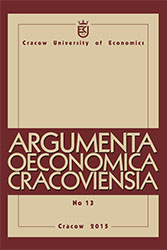Fiscal Consolidation in Hungary in 2010–13
Fiscal Consolidation in Hungary in 2010–13
Author(s): Anna MożdzierzSubject(s): Economy, National Economy, Financial Markets, Public Finances
Published by: Wydawnictwo Uniwersytetu Ekonomicznego w Krakowie
Keywords: fiscal consolidation; public finance; public debt; tax system; financial crisis; Hungary
Summary/Abstract: The purpose of this paper is to identify the fiscal consolidation methods implemented in Hungary in 2010–13 and to gauge whether adjustments on the expenditure side or on the revenue side had the greater influence on improvements in the budget balance and reduction in the public debt. The chief aim of Viktor Orbán’s government is to restrict the public debt. The instrument that was to achieve this was the Széll Kálmán plan for structural reform, which at its current stage of implementation has contributed little to improving the state of the public finances. The paper concludes from the presented evidence that the reduction in the budget deficit brought about by the consolidation measures is primarily the result of adjustments on the revenue side (increased rates of taxation, the introduction of new public levies). The paper takes the provisional position that consolidation has not proved an effective means of securing changes in the ratio of public debt to GDP.
Journal: Argumenta Oeconomica Cracoviensia
- Issue Year: 2015
- Issue No: 13
- Page Range: 43-60
- Page Count: 18
- Language: English

